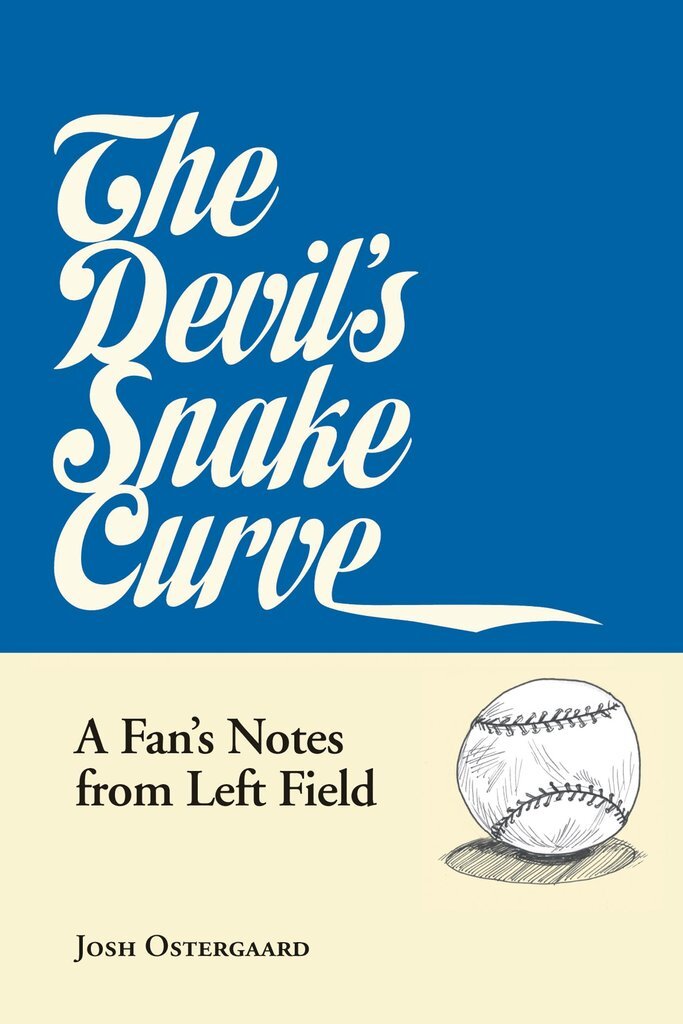The Devil’s Snake Curve: A Fan’s Notes from Left Field, by Josh Ostergaard
The Devil’s Snake Curve: A Fan’s Notes from Left Field
Josh Ostergaard
Coffee House Press, 2014
ISBN: 978-1-56689-345-9
The Devil’s Snake Curve opens in a reverie. We are dropped into the lush outfield of a youth baseball game with Josh Ostergaard, who will serve as our narrator over the course of this wry and genre-agnostic book. Rather than attend to his fielding duties, the 11-year-old Ostergaard has placed his glove on the ground so he can sample clover in deep left field. “I picked the best one,” he writes, “—not the biggest, because their nectar has usually dried, but the darkest purple bud.” He drinks from the stem. “Sweet nectar spread across my tongue.” The Devil’s Snake Curve is a book of nonfiction, although precisely what kind remains an ongoing question. Ostergaard’s decision to cold-open with an exegesis of outfield clover should tip us off. This is not a work of sports reporting. It will not dabble in Ken Burns-style hagiography. The book is occasionally memoiristic, deeply historical, and frequently interested in deconstructing baseball’s self-important mythology. Throughout, Ostergaard does not pretend toward objectivity—scorns it, in fact. He is more concerned with the subjective truths that arise from memory and interpretation. Perhaps this is a way of saying the book is a work of creative nonfiction.
Eventually our young left fielder is snapped from his clover-sipping reverie. “Coach called my name. I looked. The inning was over. My teammates were already in the dugout.” Ostergaard is in the game, but he is apart from it as well—participant and observer—and perhaps The Devil’s Snake Curve is closest to a kind of anthropology of sport. It is interested in baseball’s rituals and history, curious about its underlying meanings, and thoughtful about the way it operates in the broader culture. (It is unsurprising, then, that its author trained as an anthropologist at the University of Chicago, before later completing an MFA at the University of Minnesota.)
This anthropological perspective is an essential one, because while Ostergaard does clearly love baseball, he is well-attuned to the way sports are weaponized by the forces of late capitalism. The book is divided into five parts, among them sections called “War” and “Nationalism.” We see the New York Yankees on tour in Hiroshima in 1955, walking through a city still in ruins. We learn about the famous construction magnate, Del Webb, a former semi-pro player and co-owner of the Yankees, who built concentration camps in Arizona where Japanese Americans were imprisoned.
Ostergaard is adapt at toggling between funny personal vignettes and arch critiques of American jingoism. In one passage, he details a tense moment from his playing days in Kansas City: “I was on the pitcher’s mound, fourteen years old. But I was not a pitcher. My right arm was thin and frail, my hands too small. No curve, no slider, no knuckler, no fastball, no change, no mustache.” Predictably, young Ostergaard gets shelled during this outing and his team loses by the slaughter rule. As he slinks back to the dugout, he calculates his earned run average (fittingly, perfectly) on his calculator watch—only to arrive at the rarified ERA of 189.19. But where a less canny writer would be content with this droll teen reminiscence, Ostergaard pivots into his adult discovery that this childhood ballpark was a site of slaughter and removal for the Shawnee people, on the fiat of our former Native-murdering Commander-in-Chief, Andrew Jackson. A simple excavation of childhood becomes an opportunity for more substantive exploration.
The book is structured as a series of short vignettes with frequently ridiculous titles (“The Conveyor Belt,” “Goofs,” “You Fucked Up”), scores of entries that range from a few pages to a few sentences. This gives the book an encyclopedic sheen, although the effect is perhaps more akin to collage: over the course of The Devil’s Snake Curve, artful resonances arise, uncanny parallels develop, and we watch history repeat itself. Humorous passages are set against devastating passages are set against banal passages, and the book’s electricity comes from watching these fragments rub up against each other. In an enlightening endnote, Ostergaard addresses this and other issues of the book’s construction: “Even though I’ve been scrupulous with regard to the facts and details of baseball history—I have no interest in having my book attacked for getting George Brett’s batting average wrong—I’ve indulged in a feverish kind of radical subjectivity while assembling these factual pieces into a larger whole.”
Sports literary nonfiction has been burgeoning at least since The Paris Review’s George Plimpton tried out for the Detroit Lions (in his 1966 book Paper Lion). Recent works have successfully married reportage with personal essay with pop culture idiom (cf. Chuck Klosterman). But The Devil’s Snake Curve belongs more in the tradition of great sports novels—or great novels that involve sports—whether Frederick Exley’s 1968 masterpiece of football and alcoholism, A Fan’s Notes, or Gabe Habash’s recent exploration of college wrestling and the flimsiness of the human psyche, Stephen Florida (2017). Like these writers, Ostergaard knows his sport and loves it, but his first concerns are with theme and language and resonant imagery. Here, the liberties of creative nonfiction give him better access to those matters than straight sports writing ever could. The Devil’s Snake Curve is a successfully impressionistic book for our scattered age.
Will McGrath is the author of Everything Lost Is Found Again (Dzanc Books), which won the 2019 Society of Midland Authors Award for Biography & Memoir. He has written for The Atlantic, Pacific Standard, Guernica, and other magazines and journals. He lives in Minneapolis.


